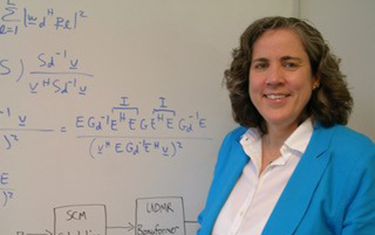
Kathleen Wage, an associate professor in the Department of Electrical and Computer Engineering, won the 2019 John Toups Presidential Medal for Excellence in Teaching.
When Kathleen Wage teaches signal processing, she doesn’t stand in front of her students and lecture for the entire period.
“That’s what a pop-star prof would do,” says Wage, an associate professor in the Department of Electrical and Computer Engineering. “I consider myself more of a DJ prof—mixing different modes of instruction to design the best learning experience.”
Her formula for an active-learning classroom: Intersperse short lecture segments with collaborative problem-solving sessions. While students work on exercises with their classmates, she moves around the room, guiding their efforts. She also augments in-class instruction with tutorial videos posted on YouTube. Her most popular video has more than 200,000 views.
Her innovative classroom strategies and dedication earned her the 2019 John Toups Presidential Medal for Excellence in Teaching, one of several teaching awards she’s received in her career.
For almost 20 years, Wage has focused on improving signal processing instruction. Her interest in interactive teaching strategies began with a project aimed at designing assessment tools for engineering educators.
A year after joining Mason in 1999, she and a friend from graduate school began a decade-long project, funded by the National Science Foundation. They developed the Signals and Systems Concept Inventory (SSCI), an assessment tool that has been administered to thousands of students at universities in the U.S. and around the world.
Concept inventories are typically administered at the beginning and end of a course to measure students’ gain in understanding. The questions examine conceptual understanding, rather than rote computational skills.
In physics, a concept inventory study prompted reforms when it showed that students in active learning courses gained approximately twice as much as students in traditional lecture courses. The SSCI study convinced Wage that switching to an interactive format was the right method.
She is working with colleagues at Mason and elsewhere to develop active-learning materials for undergraduate signal processing and acoustics classes.
Her main area of research is a synthesis of signal processing and ocean acoustics, which is funded by the Office of Naval Research. “I’m currently applying new results from mathematics to analyze and improve algorithms for processing data from larger and larger arrays of sensors,” she says.
Sometimes she’s able to weave that research into classroom discussions. “I love using experimental data from deep water arrays to illustrate applications of abstract signal-processing concepts.”
Signal processing is mathematical, and students don’t always see the connection to engineering, she says. “The challenge of it is convincing them that these are tools that will be helpful if they put some effort into learning them.”
What she likes most about teaching is “getting students excited about the material and helping them develop critical-thinking skills that apply to my course and beyond.
“At Mason, I am grateful to have found a community of other DJ profs who are devoted to improving their pedagogical playlists and engaging students in learning.”
